Balbharti Maharashtra State Board 12th Biology Important Questions Chapter 1 Reproduction in Lower and Higher Plants Important Questions and Answers.
Maharashtra State Board 12th Biology Important Questions Chapter 1 Reproduction in Lower and Higher Plants
Multiple-choice questions
Question 1.
In grafting, the rooted plant is used as a ………………
(a) scion
(b) stock
(c) stem
(d) root
Answer:
(b) stock
Question 2.
The method of propagation by root cutting is practised in ………………
(a) Rose
(b) Bougainvillea
(c) Sansevieria
(d) Blackberry
Answer:
(d) Blackberry
![]()
Question 3.
Monothecous anther has ……………… pollen sacs.
(a) single
(b) two
(c) three
(d) four
Answer:
(b) two
Question 4.
In wall of mature anther, ……………… shows fibrous thickenings.
(a) epidermis
(b) endothecium
(c) middle layer
(d) tapetum
Answer:
(b) endothecium
Question 5.
Intine consists of ………………
(a) cellulose and pectin
(b) cellulose and chitin
(c) cellulose and starch
(d) cellulose and sporopollenin
Answer:
(a) cellulose and pectin
Question 6.
The stalk of the ovule that attaches to placenta is ……………… which is attached at to the body of ovule.
(a) chalaza, hilum
(b) hilum, funiculus
(c) funiculus, hilum
(d) micropyle, hilum
Answer:
(c) funiculus, hilum
Question 7.
……………… is multicellular structure embedded in nucellus.
(a) Micropyle
(b) Chalaza
(c) Embryo sac
(d) Endothecium
Answer:
(c) Embryo sac
Question 8.
The transfer of pollen grains from the anther to the stigma is called ………………
(a) pollination
(b) fertilization
(c) transpiration
(d) viability
Answer:
(a) pollination
Question 9.
This condition is not favourable for autogamy in flowers.
(a) Bisexuality
(b) Homogamy
(c) Cleistogamy
(d) Herkogamy
Answer:
(d) Herkogamy
Question 10.
From the following, mechanism of pollination by abiotic agent is ………………
(a) Ornithophily
(b) Anemophily
(c) Entomophily
(d) Chiropterophily
Answer:
(b) Anemophily
Question 11.
In which type of flowers, the pollen grains are ribbon like without exine?
(a) Anemophilous
(b) Epihydrophilous
(c) Hypohydrophilous
(d) Entomophilous
Answer:
(c) Hypohydrophilous
Question 12.
Which flower exhibits turn pipe mechanism of pollination?
(a) Salvia
(b) Zostera
(c) Oestrum
(d) Callistemon
Answer:
(a) Salvia
Question 13.
The phenomenon of pollen grains of other flowers germinate rapidly on stigma than the pollen grains of same flower is ………………
(a) Protoandry
(b) Protogyny
(c) Prepotency
(d) Pollination
Answer:
(c) Prepotency
Question 14.
Inhibition of germination of pollen on stigma of same flower is ………………
(a) self-sterility
(b) self-pollination
(c) self compatibility
(d) selfing
Answer:
(a) self-sterility
Question 15.
The stigma provides ……………… for germination of pollen on it.
(a) oxygen
(b) water
(c) pectin
(d) malic acid
Answer:
(b) water
Question 16.
For successful artificial hybridization, these processes are essential.
(a) Disbudding and Bagging
(b) Budding and Bagging
(c) Emasculation and Budding
(d) Emasculation and Bagging
Answer:
(d) Emasculation and Bagging
Question 17.
Continued self-pollination results in ………………
(a) Hybrid vigour
(b) Genetic variability at greater extent
(c) Inbreeding depression
(d) Introduction of desired traits
Answer:
(c) Inbreeding depression
Question 18.
Heterostyly : Primula flowers : : Herkogamy: ?
(a) Gloriosa
(b) Calotropis
(c) Thea
(d) Salvia
Answer:
(b) Calotropis
Question 19.
The substance having key role in recognition and compatibility of pollen in pollen – pistil interaction is ………………
(a) special proteins
(b) special lipids
(c) pollenkitt
(d) sucrose
Answer:
(a) special proteins
Question 20.
This is NOT a type but variation in endosperm.
(a) Cellular
(b) Helobial
(c) Nuclear
(d) Mosaic
Answer:
(d) Mosaic
Question 21.
In monocot embryo, the single cotyledon is ……………… shaped and it is called ………………
(a) oval, scutellum
(b) shield, scutellum
(c) angle, coleoptile
(d) angle, coleorhiza
Answer:
(b) shield, scutellum
Question 22.
Endospermic seed : Maize : : Non-endospermic seed : ?
(a) Castor
(b) Coconut
(c) Wheat
(d) Bean
Answer:
(d) Bean
Question 23.
The integuments of fertilized ovule form the ………………
(a) seed
(b) seed coat
(c) hilum
(d) perisperm
Answer:
(b) seed coat
![]()
Question 24.
When diploid sporophytic cell forms diploid gametophyte without meiosis, it is phenomenon of ………………
(a) apogamy
(b) apocarpy
(c) apospory
(d) apoptosis
Answer:
(c) apospory
Question 25.
Which chemical substance is responsible for fruit development by Parthenocarpy?
(a) Malic acid
(b) Sucrose
(c) Boric acid
(d) Indole acetic acid
Answer:
(d) Indole acetic acid
Question 26.
Citrus seeds : Polyembryony : : Papaya fruits : ?
(a) Diplospory
(b) Apogamy
(c) Parthenocarpy
(d) Apospory
Answer:
(c) Parthenocarpy
Question 27.
Who discovered the phenomenon of double fertilization?
(a) Noll
(b) Maheshwari
(c) Leeuwenhoek
(d) Nawaschin
Answer:
(d) Nawaschin
Question 28.
When embryo development takes place the first cell of the suspensor which is towards micropylar end functions as ………………
(a) hypophysis
(b) haustorium
(c) scutellum
(d) plumule
Answer:
(b) haustorium
Question 29.
Point out the odd one.
(a) Coleoptile
(b) Coleorhiza
(c) Scutellum
(d) Perisperm
Answer:
(d) perisperm
Question 30.
Select the plant having both chasmogamous and cleistogamous flowers.
(a) Viola
(b) Primula
(c) Thea
(d) Fritillaria
Answer:
(a) Viola
Question 31.
Identify the mismatched pair.
(a) Cellular endosperm – Balsam
(b) Nuclear endosperm – Wheat
(c) Helobial endosperm – Asphodelus
(d) Mosaic endosperm – Coconut
Answer:
(d) Mosaic endosperm – Coconut
Question 32.
Up to which stage embryo development is similar in dicots and monocots?
(a) Proembryo
(b) Quadrant
(c) Octant
(d) Heart-shaped
Answer:
(c) Octant
Question 33.
The cross pollination within the same species is also called ………………
(a) hybridization
(b) xenogamy
(c) allogamy
(d) autogamy
Answer:
(b) xenogamy
Question 34.
In a recently fertilized ovule, the haploid, diploid and triploid conditions are respectively seen in ………………
(a) endosperm, nucellus, egg
(b) egg, nucellus, endosperm
(c) antipodals, oospore, primary endosperm nucleus
(d) polar nuclei, secondary nucleus, endosperm
Answer:
(c) antipodals, oospore, primary endosperm nucleus
Question 35.
In sunflower, self-pollination is avoided by ………………
(a) protogyny
(b) unisexuality
(c) self-sterility
(d) protandry
Answer:
(d) protandry
Question 36.
A versatile anther is an adaptation for ……………… type of pollination.
(a) anemophilous
(b) entomophilous
(c) hydrophilous
(d) ornithophilous
Answer:
(a) anemophilous
Question 37.
The endosperm cells in an angiospermic plant has 18 chromosomes, the number of chromosomes in its root cells will be ………………
(a) 12
(b) 6
(c) 18
(d) 24
Answer:
(a) 12
Question 38.
In porogamy, the pollen tube enters into the ovule through ………………
(a) micropyle
(b) integuments
(c) chalaza
(d) funicle
Answer:
(a) micropyle
Question 39.
Which of the following is not floral adaptation for entomophily?
(a) Large flowers
(b) Bright coloured flowers
(c) Sweet scented flowers
(d) Small inconspicuous flowers
Answer:
(d) small inconspicuous flower
Question 40.
Pollination through water is called ………………
(a) zoophily
(b) hydrophily
(c) anemophily
(d) entomophily
Answer:
(b) hydrophily
Question 41.
The types of pollination exhibited by Vallisneria and Zea mays respectively are ………………
(a) anemophily and hydrophily
(b) entomophily and hydrophily
(c) hydrophily and anemophily
(d) hydrophily and entomophily
Answer:
(c) hydrophily and anemophily
Question 42.
The union of male gamete with the female gamete is called ………………
(a) autogamy
(b) allogamy
(c) fertilization
(d) pollination
Answer:
(c) fertilization
Question 43.
The secondary nucleus is formed by the fusion of ………………
(a) two polar nuclei
(b) three nuclei
(c) two synergids
(d) two antipodal cells
Answer:
(a) two polar nuclei
Question 44.
A group of three cells situated at the base of the embryo sac are called ………………
(a) tube
(b) generative
(c) synergid
(d) antipodal
Answer:
(d) antipodal
Question 45.
The female gametophyte in angiosperms is a ……………… nucleated structure.
(a) 3
(b) 4
(c) 5
(d) 8
Answer:
(d) 8
Question 46.
In artificial hybridization, pollen grains are pollinated by ………………
(a) wind
(b) insect
(c) birds
(d) hand
Answer:
(d) hand
Question 47.
Which of the following does not occur in the embryo sac of angiosperms?
(a) egg apparatus
(b) secondary nucleus
(c) antipodal cells
(d) raphe
Answer:
(d) raphe
Question 48.
To produce 500 pollen grains, how many microspore mother cells are required ?
(a) 500
(b) 125
(c) 250
(d) 1000
Answer:
(b) 125
![]()
Question 49.
How many meiotic divisions are required for the formation of 100 seeds ?
(a) 25
(b) 50
(c) 100
(d) 125
Answer:
(b) 50
Question 50.
During fertilization, male gametes are carried by pollen tube. This is called ………………
(a) syngamy
(b) siphonogamy
(c) mesogamy
(d) polygamy
Answer:
(b) siphonogamy
Question 51.
In bisexual flowers, maturation of gynoecium before androecium is known as ………………
(a) protandry
(b) protogyny
(c) gynandry
(d) dicliny
Answer:
(b) protogyny
Question 52.
……………… is formed in angiosperms by triple fusion.
(a) Testa
(b) Integument
(c) Endosperm
(d) Suspensor
Answer:
(c) Endosperm
Question 53.
The minimum number of meiotic divisions required to produce 120 viable seeds in pea plant is ………………
(a) 150
(b) 60
(c) 120
(d) 90
Answer:
(a) 150
Question 54.
Ornithophily is effected by ………………
(a) snails
(b) insects
(c) bats
(d) birds
Answer:
(d) birds
Question 55.
Synergids are ………………
(a) haploid
(b) triploid
(c) diploid
(d) tetraploid
Answer:
(a) haploid
Question 56.
Egg apparatus consists of ………………
(a) egg and antipodals
(b) egg and polar nuclei
(c) egg and synergids
(d) egg and secondary nucleus
Answer:
(c) egg and synergids
Question 57.
Embryo sac is ………………
(a) microgametophyte
(b) microsporangium
(c) megagame tophyte
(d) megasporangium
Answer:
(c) megagametophyte
Question 58.
If the number of chromosomes in an endosperm cell is 27, what will be the chromosome number in the definitive nucleus?
(a) 9
(b) 18
(c) 27
(d) 36
Answer:
(b) 18
Question 59.
How many meiotic divisions will be needed to produce 44 female gametophytes in angiosperms?
(a) 11
(b) 22
(c) 44
(d) 66
Answer:
(c) 44
Question 60.
Endosperm of angiosperm is ………………
(a) haploid
(b) diploid
(c) triploid
(d) tetraploid
Answer:
(c) triploid
Match the columns
Question 1.
| (1) Column A (Asexual) | Column B (Examples) |
| (1) Spore formation | (a) Spirogyra |
| (2) Conidia formation | (b) Yeast |
| (3) Fragmentation | (c) Chlamydomonas |
| (4) Budding | (d) Penicillium |
Answer:
| (1) Column A (Asexual) | Column B (Examples) |
| (1) Spore formation | (c) Chlamydomonas |
| (2) Conidia formation | (d) Penicillium |
| (3) Fragmentation | (a) Spirogyra |
| (4) Budding | (b) Yeast |
Question 2.
| Column A (Artificial Vegetative Propagation) | Column B (Examples) |
| (1) Leaf cutting | (a) Blackberry |
| (2) Stem cutting | (b) Apple |
| (3) Grafting | (c) Bougainvillea |
| (4) Root cutting | (d) Sansevieria |
Answer:
| Column A (Artificial Vegetative Propagation) | Column B (Examples) |
| (1) Leaf cutting | (d) Sansevieria |
| (2) Stem cutting | (c) Bougainvillea |
| (3) Grafting | (b) Apple |
| (4) Root cutting | (a) Blackberry |
Question 3.
| Column A (Part of Anatropous ovule) | Column B (Terminology) |
| (1) Opening at the apex | (a) Hilum |
| (2) Stalk of the ovule | (b) Integument |
| (3) Protective covering | (c) Micropyle |
| (4) Place of attachment of body and stalk | (d) Funiculus |
Answer:
| Column A (Part of Anatropous ovule) | Column B (Terminology) |
| (1) Opening at the apex | (c) Micropyle |
| (2) Stalk of the ovule | (d) Funiculus |
| (3) Protective covering | (b) Integument |
| (4) Place of attachment of body and stalk | (a) Hilum |
![]()
Question 4.
| Column A (Adaptation) | Column B (Type of pollination) |
| (1) Sticky, spiny pollen grains non-fragrant flowers | (a) Anemophily |
| (2) Feathery stigma and versatile anther | (b) Chiropterophily |
| (3) Presence of nectar glands and sweet smell | (c) Ornithophily |
| (4) Dull coloured flowers with strong fragrance | (d) Entomophily |
Answer:
| Column A (Adaptation) | Column B (Type of pollination) |
| (1) Sticky, spiny pollen grains non-fragrant flowers | (c) Ornithophily |
| (2) Feathery stigma and versatile anther | (a) Anemophily |
| (3) Presence of nectar glands and sweet smell | (d) Entomophily |
| (4) Dull coloured flowers with strong fragrance | (b) Chiropterophily |
Question 5.
| Column A (Mechanism) | Column B (Type of pollination) |
| (1) Geitonogamy | (a) Thea |
| (2) Herkogamy | (b) Gloriosa |
| (3) Self-sterility | (c) Cucurbita |
| (4) Protogyny | (d) Calotropis |
Answer:
| Column A (Mechanism) | Column B (Type of pollination) |
| (1) Geitonogamy | (c) Cucurbita |
| (2) Herkogamy | (d) Calotropis |
| (3) Self-sterility | (a) Thea |
| (4) Protogyny | (b) Gloriosa |
Question 6.
| Column A | Column B |
| (1) Nutritive tissue of embryo | (a) Perisperm |
| (2) Remnants of nucellus in seed | (b) Cotyledon |
| (3) Nutritive tissue of developing microspores | (c) Endosperm |
| (4) First photosynthetic organ of embryo | (d) Tapetum |
Answer:
| Column A | Column B |
| (1) Nutritive tissue of embryo | (c) Endosperm |
| (2) Remnants of nucellus in seed | (a) Perisperm |
| (3) Nutritive tissue of developing microspores | (d) Tapetum |
| (4) First photosynthetic organ of embryo | (b) Cotyledon |
Very short answer questions
Question 1.
What is budding in plants?
Answer:
Budding in plants is an artificial method of propagation in which a single bud is joined or grafted on the stock plant.
Question 2.
What is the function of flower?
Answer:
Flower is a specialized reproductive structure which produces haploid gametes and ensures that act of fertilization will take place.
Question 3.
Enlist the wall layers of mature anther.
Answer:
Epidermis, endothecium, middle layer and tapetum are observed from outside to inside.
Question 4.
What is the peculiarity of angiospermic gametophytes ?
Answer:
The gametophytes are reduced and develop within the flower.
Question 5.
Enlist the layers of sporoderm and their composition.
Answer:
Outer layer exine is composed of sporopollenin and inner layer intine composed of cellulose and pectin.
Question 6.
What is endosporous development of embryo sac?
Answer:
The development of female gametophyte occurs within the megaspore itself.
Question 7.
Enlist the chief agents responsible for pollination process of plants.
Answer:
Abiotic agents – wind, water and Biotic agents – insects, birds, bats.
Question 8.
Describe the characters of pollens of anemophilous flowers.
Answer:
The pollen grains are produced in large number from versatile anthers and are dry, light in weight for their easy dispersal.
Question 9.
What is hay fever?
Answer:
It is the allergic symptoms observed in people who are sensitive to pollen grains mainly of anemophilous plants.
Question 10.
Enlist the different types of pollination observed in aquatic plants.
Answer:
Aquatic plants have hypohydrophilous, epihydrophilous, anemophilous as well as entomophilous type of pollination.
Question 11.
What is the main role of pistil in pollen- pistil interaction?
Answer:
As pollen grain is deposited on stigma, pistil has the ability to recognise and accept the compatible pollen of same species for further germination.
Question 12.
What type is the endosperm of coconut?
Answer:
Coconut has free nuclear vacuolated endosperm in the centre with multicellular endosperm in the outer part.
Question 13.
What is the origin of embryos in adventive polyembryony ?
Answer:
The embryos develop from diploid cells of nucellus and integuments.
Question 14.
What is vegetative propagation ?
Answer:
The reproduction which occurs with the help of vegetative organs like root, stem, leaf or bud is called vegetative reproduction or vegetative propagation.
Question 15.
What is grafting ?
Answer:
Grafting is an artificial method of vegetative propagation in which the parts of two different plants are combined in such a way that they unite with each other and continue their growth as one plant.
Question 16.
What is triple fusion?
Answer:
The process involving the fusion of a male gamete with the diploid secondary nucleus to form a triploid primary endosperm nucleus is called triple fusion.
Question 17.
What is syngamy ?
Answer:
The fusion of male gamete with the egg or oosphere to form diploid zygote or oospore is called syngamy.
Question 18.
What are the two major modes of reproduction in angiosperms ?
Answer:
The two major modes of reproduction in angiosperms are asexual reproduction and sexual reproduction.
Question 19.
What is the main feature of asexual reproduction ?
Answer:
The main feature of asexual reproduction is that it is uniparental and the offspring produced are genetically identical to the parents.
Question 20.
What is sexual reproduction ?
Answer:
The method of reproduction which involves the formation and fusion of gametes is called sexual reproduction.
Question 21.
Name the initial cells of the male and female gametophytes.
Answer:
The haploid microspores (n) and megaspores (n) are the initial cells of the male and female gametophytes.
Question 22.
At which stage, the pollen grains are liberated in the most angiosperms ?
Answer:
The pollen grains are liberated at 2-celled stage in most angiosperms.
Question 23.
What is an anatropous ovule ?
Answer:
The ovule which has a downwardly directed micropyle is called an anatropous ovule.
Question 24.
Give the scientific term used for water pollinated flowers.
Answer:
The scientific term used for water pollinated flowers is hydrophilous.
Question 25.
Give one example each of dicot endospermic seed and non-endospermic seed.
Answer:
- Endospermic seed : Castor
- Non-endospermic seed : Bean.
Question 26.
What is dichogamy?
Answer:
Maturation of anther and stigma at different times is called dichogamy.
Question 27.
How is diploid condition restored in angiosperms ?
Answer:
In angiosperms, the diploid condition is restored by the fusion of two haploid gametes.
![]()
Question 28.
What is egg apparatus ?
Answer:
The egg apparatus is a three-celled structure lying at the micropylar end of the embryo sac.
Question 29.
Why are some seeds of citrus referred to as polyembryonic?
Answer:
When the seeds of citrus germinate, we notice development of multiple seedling. This is due to adventive embryos formed in the seeds in addition to zygotic embryo.
Give definition/meaning of the following terms
Question 1.
Reproduction
Answer:
Reproduction is the process by which offspring is produced which resembles the parents.
Question 2.
Clones
Answer:
Morphologically and genetically identical individuals are called clones.
Question 3.
Scion
Answer:
The part of the stem containing more than one bud which is joined onto a rooted plant.
Question 4.
Stock
Answer:
Stock is a rooted plant on which part of the stem (scion) is joined in grafting.
Question 5.
Microsporogenesis
Answer:
The process in which each microspore mother cell divides meiotically to form tetrad of haploid microspores (pollen grains).
Question 6.
Pollen viability
Answer:
It is the ability of pollen grains to germinate and develop into male gametophyte.
Question 7.
Pollination
Answer:
Pollination is the transfer of pollen grains from anther to the stigma of flower.
Question 8.
Autogamy
Answer:
Autogamy is a type of pollination in which bisexual flower is pollinated by its own pollen grains.
Question 9.
Dioecism
Answer:
Dioecism is condition in which the plant bears either male or female flower and it is also called unisexuality.
Question 10.
Double fertilization
Answer:
The process of fertilization where both the male gametes participate in the complex fertilization mechanism seen in angiosperms is called double fertilization.
Question 11.
Embryogenesis
Answer:
The process of development of zygote into an embryo is called embryogenesis.
Question 12.
Dormancy
Answer:
Structural or physiological adaptive mechanism for survival is called dormancy.
Question 13.
Polyembryony
Answer:
The condition in which there is development of more than one embryo inside the seed is called polyembryony.
Give significance / importance of the following
Question 1.
Reproduction
Answer:
Reproduction is an essential process that leads to continuation of species. It also maintains the continuity of life.
Question 2.
Asexual reproduction
Answer:
The fusion of sex cells is not involved in this process thus it results in the production of genetically identical progeny from a single parent.
Question 3.
Vegetative Reproduction/Propagation
Answer:
The plants reproduce asexually from their vegetative plant parts and thus new plants formed are genetically similar to their parents.
Question 4.
Sexual reproduction
Answer:
It involves fusion of two compatible gametes and thus it results in production of genetically dissimilar offspring. Variations are set in, which are important from point of view of survival and evolution of species.
Question 5.
Exine
Answer:
Outer thick layer of pollen grain which is made up of complex non- biodegradable sporopollenin that is resistant to chemicals.
Question 6.
Germ pores
Answer:
These are thin areas in the exine, through which developing pollen tube emerges out during pollen germination.
Question 7.
Pollen viability
Answer:
The functional viability of pollen grain to form male gametophyte. It can germinate in favourable environmental conditions of suitable temperature and humidity.
Question 8.
Synergid/Filiform apparatus
Answer:
It is present in egg apparatus of embryo sac (female gametophyte) which directs the pollen tube towards the egg cell due to chemicals secreted.
Question 9.
Pollination
Answer:
Non-motile pollen grains are transferred on stigma of flower with some external abiotic or biotic agents.
Question 10.
Autogamy/Self-pollination
Answer:
In a bisexual flower, when it is pollinated by its own pollen grain the offspring formed are genetically identical to their parents.
Question 11.
Xenogamy/Cross pollination/Outbreeding
Answer:
When cross pollination takes place then that generates genetically, varied offspring.
Question 12.
Heterostyly/Heteroanthy (Heteromorphy)
Answer:
When in some flowers; stigmas and anthers are placed at different levels then it prevents self-pollination by preventing pollens to reach the stigma.
Question 13.
Double fertilization
Answer:
- It ensures seed formation with food storage for embryo developed from fertilized egg.
- Diploid zygote develops into embryo which further forms a new plant.
- Triploid PEN forms endosperm which is nutritive tissue for embryo.
- Restoration of diploid condition by syngamy.
Question 14.
Endosperm
Answer:
It is nutritive tissue of embryo developed in post-fertilization changes which also triggers the growth of embryo in proper manner.
Question 15.
Seed formation
Answer:
Seeds are important propagating units of plant and their dispersal helps in distribution of species.
Question 16.
Fruit formation
Answer:
Nourishment to the developing seeds and protection of the immature seeds is role of fruit formation.
Question 17.
Apomixis
Answer:
When embryo(s) are formed through asexual method of reproduction without gamete formation, genetically identical plants can be produced rapidly and effectively by apomixis.
Question 18.
Parthenocarpy
Answer:
Development of fruit without the process of fertilization results in formation of seedless fruit.
Question 19.
Polyembryony
Answer:
As there is development of more than one embryo in the seed it increases the chances of survival of new plants.
Name the following
Question 1.
Condition in flower when androecium matures before that of gynoecium.
Answer:
Protandry
Question 2.
Method of asexual reproduction in sponges.
Answer:
Gemmule formation
Question 3.
Method in which small amount of plant tissue is carefully grown.
Answer:
Tissue culture.
Question 4.
Recent or Modern method of vegetative reproduction of plants form plant tissue.
Answer:
Micropropagation.
![]()
Question 5.
Most common type of ovule in angiosperms.
Answer:
Anatropous
Question 6.
A diploid nucleus in central cell of embryo sac in plants.
Answer:
Secondary nucleus or definitive nucleus
Question 7.
A condition of flowers where its sex organs are exposed.
Answer:
Chasmogamy.
Question 8.
Components necessary to induce germination of pollen in synthetic medium.
Answer:
Sucrose and boric acid.
Question 9.
The plant material in which double fertilization was discovered.
Answer:
Liliaceae plants like Lilium and Fritillaria.
Question 10.
A condition in which pollen tube enters the ovule through micropyle, through chalaza or through integuments.
Answer:
Porogamy, chalazogamy and mesogamy respectively.
Question 11.
Non-motile male gametes are carried through hollow tube when pollen grain germinate.
Answer:
Siphonogamy
Question 12.
Layers of seed coat.
Answer:
Outer testa and inner tegmen
Question 13.
A state of metabolic arrest that helps in survival of organism In adverse conditions.
Answer:
Dormancy.
Question 14.
Name the nuclei taking part in triple fusion.
Answer:
The nucleus of male gamete and the secondary nucleus formed by fusion of two polar nucleI.
Question 15.
What do you call the kernel that you eat in tender coconut?
Answer:
Coconut meat (kopra)
Distinguish between
Question 1.
Asexual Reproduction – Sexual Reproduction
Answer:
| Asexual Reproduction | Sexual Reproduction |
| 1. Fusion of sex cells or two compatible gametes is not involved. | 1. Fusion of sex cells or two compatible gametes is involved. |
| 2. It results in production of genetically identical progeny. | 2. It results in production of genetically dissimilar offspring. |
| 3. Offspring inherit genes of the parent. | 3. Offspring have combination genes from both the parents through their gametes. |
| 4. Variations are not observed in progeny. | 4. Variations due to recombination are observed which are useful for survival and evolution of species. |
Question 2.
Autogamy (Self-pollination) – Xenogamy (cross pollination)
Answer:
| Autogamy (Self-pollination) | Xenogamy (Cross pollination) |
| 1. In self-pollination, bisexual flower is pollinated by its own pollen grains. | 1. In cross pollination the pollen grains from the anther are carried to the stigma of another flower of same species. |
| 2. Self-pollination does not depend upon external agents for pollination. | 2. Cross pollination does depend upon external agents for pollination. |
| 3. Self-pollination is economical as there is no wastage of pollen grains. | 3. Cross pollination is not economical as there is wastage of pollen grains during transfer. |
| 4. Offspring are genetically similar to their parents; E.g. Pea | 4. Offspring are genetically varied due to recombination. E.g. Food and fibre crops – Maize, Rice. |
Question 3.
Hypohydrophily – Epihydrophily
Answer:
| Hypohydrophily | Epihydrophily |
| 1. Pollination takes place below the surface of water. | 1. Pollination takes place on the surface of water. |
| 2. Pollen grains are heavier and they sink in water. | 2. Pollen grains float on the water surface. |
| 3. Pollens are long, ribbon like without exine. | 3. Pollens have specific gravity equal to water. |
| 4. E.g. Zostera (sea grass) | 4. E.g. Vallisneria |
Give scientific reasons
Question 1.
The development of embryo sac is described as monosporic.
Answer:
- Embryo sac develops inside the nucellus of ovule from megaspore.
- Megaspore mother cell is diploid structure which undergoes meiosis.
- After meiosis, tetrad of haploid cells are produced.
- The upper three megaspores degenerate and the lower one of the tetrad is functional.
- The entire embryo sac is developed by elongation and then three mitotic divisions of this single megaspore take place hence the development is described as monosporic.
Question 2.
Pollination is prerequisite for fertilization in plants.
Answer:
- Fertilization is fusion of male and female gametes.
- Pollination is transfer of pollen grains which carry non-motile male gametes.
- Pollen grains are transferred from anther to stigma of flower where they germinate.
- Both male and female gametes are non- motile and they are produced at two different sites.
- Therefore the pollination process is necessary for act of fertilization in plants.
Question 3.
Dichogamy favours cross pollination.
Answer:
- Maturation of anther (stamen) and stigma (carpel) at different times is called dichogamy.
- Dichogamy is of two types, viz, protandry and protogyny.
- Maturity of anthers before that of gynoecium is protandry and maturity of carpel before maturity of pollen grains is protogyny.
- As this forms barrier for self-pollination, dichogamy favours cross pollination.
Question 4.
Fertilization in angiosperms is double fertilization.
Answer:
- In angiosperms, pollen tube carries two non-motile male gametes.
- Pollen tube enters the embryo sac in synergids and the contents are relased.
- Out of the two male gametes produced by the male gametophyte, one unites with female gamete i.e syngamy and the other with the secondary nucleus i.e. triple fusion.
- Since both the male gametes take part in fertilization which takes place twice, it is called double fertilization.
Question 5.
Castor seed is endospermic or albuminous.
Answer:
- Endosperm, that is developed after fertilization is a nutritive tissue for developing embryo.
- Endosperm stores food material.
- In some seeds this reserved food is partially utilized by embryo for development, E.g; Castor.
- The endosperm remains in the seed and it is utilized further during seed germination. Hence the seed is endospermic or albuminous.
![]()
Question 6.
Parthenocarpic fruits are without seeds.
Answer:
- In parthenocarpy, fruit is developed without fertilization.
- When fertilization takes place ovules in the ovary are transformed into seeds.
- In parthenocarpy, for fruit development chemical stimulus from placental tissue transforms or stimulates ovary into fruit but it is seedless.
Question 7.
Nucellar polyembryony is significant in horticulture.
Answer:
- Polyembryony is a phenomenon where we get many embryos in the seed.
- Polyembryony increases chances of survival of plants as there are multiple seedlings formed.
- Nucellar embryos are formed from diploid parental tissue.
- Thus genetically uniform type of seedlings are obtained which are similar to parents.
Write the short notes on the following
Question 1.
Vegetative reproduction.
Answer:
- It is asexual method of reproduction.
- Plants reproduce through their vegetative plant parts.
- New plants produced are genetically identical to their parents.
- It is very useful in agriculture and horticulture.
- Artificial methods like cutting and grafting are useful for propagation of desired varieties as per human needs.
Question 2.
Grafting.
Answer:
- It is type of artificial vegetative propagation.
- In this method two different plants are joined together.
- The part of stem containing one or more buds is scion which is joined on a rooted plant stock.
- They grow as one plant, e.g. Apple, Pear, Mango.
- When a single bud is grafted on a stock plant it is known as bud grafting or budding, e.g. Rose.
Question 3.
Pollen Viability.
Answer:
- It is a functional ability of pollen grain to form male gametophyte by its germination.
- Viable pollen grains germinate on stigmatic surface,
- Environmental factors mainly temperature and humidity influence its germination.
- Viability is low up to 30 minutes in plants like rice and wheat.
- Duration of viability is up to months in some plants of family Leguminosae, Rosaceae and Solanaceae.
Question 4.
Seed Dormancy.
Answer:
- It is a state of metabolic arrest which helps in survival of organism in unfavourable environmental conditions.
- Structure or physiological adaptive measures of seed that are helpful in adverse conditions is called dormancy.
- Seeds are dispersed during their dormancy.
- When dormancy period of seeds is completed then only the viable seed germinate.
Question 5.
Parthenocarpy.
Answer:
- It is a condition in which fruit is developed without event of fertilization.
- It is a natural process observed on Pineapple and Banana.
- A chemical stimulus in the form of auxin (IAA) is given by placental tissues of unfertilized ovary.
- Due to the stimulus, enlargement of ovary takes place to form a fruit.
- Parthenocarpic fruits are without seeds.
Question 6.
Polyembryony.
Answer:
- It is a condition when more than one embryos are developed inside the seed.
- It was first noticed in Citrus by Leeuwenhoek.
- When embryos develop from diploid cells of nucellus or integuments, it is described as adventive polyembryony.
- When zygote divides into small units which develop into embryos then it is called cleavage polyembryony.
- It results in multiple seedlings and is of significance in horticulture.
Question 7.
Anemophily.
Answer:
- The transfer of pollen grains through wind is called anemophily.
- Plants that are pollinated by wind are called anemophilous plants.
- Anemophilous plants bear small and inconspicuous flowers without any bright colours, fragrance and nectar.
- Flowers are produced in large numbers.
- Stamens are long with versatile anthers.
- Stigma is feathery, exposed to receive the pollen grains coming along with the wind, e.g. Grasses, maize, Jowar and Palms.
Question 8.
Hydrophily.
Answer:
- The transfer of pollen grains with the help of water is called hydrophily.
- Plants that are pollinated by water are called hydrophilous plants.
- Hydrophilous plants possess small, inconspicuous unisexual flowers.
- Flowers lack fragrance, nectar and bright colour.
- Pollen grains and other floral parts are protected from getting wet.
- Stigma is long and sticky, e.g. Zostera, Vallisneria, etc.
Question 9.
Omithophily.
Answer:
- The transfer of pollen grains through birds is called ornithophily.
- Bird pollinated plants are called ornithophilous plants.
- Ornithophilous plants bear large and showy flowers.
- Flowers brightly coloured to attract birds for pollination.
- Ornithophilous flowers lack fragrance as birds have poor sense of smell.
- Pollen grains are sticky and spiny e.g. Callistemon, Bignonia, Bombax, Butea, etc.
Question 10.
Dichogamy.
Answer:
- When stamens and carpels mature at different times in a bisexual flower, the condition is known as dichogamy.
- Owing to dichogamy self-pollination is avoided and cross pollination is favoured.
- Dichogamy is of two types, viz., protandry and protogyny.
- Protandry is seen in sunflower in which pollen grains are released much before stigma becomes receptive.
- In protogyny, stigma becomes ready to receive the pollen grains before the anthers mature. It is seen in plants like Gloriosa.
Question 11.
Embryo sac.
Answer:
- Egg apparatus is a three celled structure lying at the micropylar end of the embryo sac.
- The egg apparatus consists of a median egg cell called oosphere and two lateral cells called synergids.
- The embryo sac also consists of three antipodal cells or antipodals towards the chalazal end which degenerate after fertilization.
- In the centre, the embryo sac consists of a large central cell consisting of two haploid polar nuclei.
- The polar nuclei at a later stage fuse with each other forming a diploid secondary nucleus.
- The secondary nucleus develops into endosperm.
Question 12.
Entomophily.
Answer:
- Pollination with the help of insects is called entomophily.
- The insect pollinated flowers are called J entomophilous flowers.
- Entomophilous flowers show the following adaptations:
- Flowers are large and attractive.
- Flowers are brightly coloured with i pleasant smell.
- Flowers produce nectar which is food for the insects.
- Pollen grains are spiny and sticky for easy adherance to the rough and sticky stigma.
- Entomophily is seen in plants like rose, Jasmine, Oestrum, Salvia, etc.
Question 13.
Endosperm.
Answer:
- Endosperm is a nutritive tissue. It nourishes the developing embryo.
- The endosperm develops from the primary endosperm nucleus (PEN).
- The endosperm is a post fertilization tissue.
- There are two types of seeds depending upon the presence or absence of endosperm, viz., endospermic and non-endospermic.
- Castor, coconut, maize, etc. are endospermic seeds, while bean, pea, gram, etc. are non-endospermic seeds.
![]()
Question 14.
Triple fusion.
Answer:
- Triple fusion is also called second fertilization.
- Out of the two male gametes in angiosperms, the first one fuses with the egg to form the zygote, while the second one fuses with the secondary nucleus to form primary endosperm nucleus. This is called triple fusion. Since each of the polar nuclei is a sister nucleus of the egg, it is called second fertilization.
- First fusion involves the fusion of a male gamete with the egg; the second fusion involves the fusion of two polar nuclei to form the secondary nucleus and the third fusion involves the fusion of the other male gamete with the secondary nucleus.
Short Answer Questions
Question 1.
What is asexual reperoduction? Describe fragmentation.
Answer:
- Production of offspring without involving fusion of two compatible gametes or sex cells is called asexual reproduction.
- Fragmentation : It is a type of asexual reproduction observed in lower plants, e.g. algae.
- Multicellular organisms break into small pieces called fragments which develop into new plant.
- These fragments are formed due to different reasons like accidental breakdown, death and decay of cells, etc.
Question 2.
Explain about artificial methods of vegetative reproduction.
Answer:
- Vegetative propagation is a kind of asexual reproduction which occurs with the help of vegetative plant parts.
- Cutting and grafting are two methods used to propagate desired varieties of plants.
- Cutting – small pieces of plant parts having one or more buds are selected for propagation, e.g, Stem cutting – Rose, Root Cutting – Blackberry and Leaf cutting – Sansevieria.
- Grafting – In this method two plant parts are joined ogether (Stock – rooted plant and Scion-attached plant and they continue their growth as one plant.
- When a single bud is grafted on stock plant it is called as bud grafting, e.g. Rose, Apple, Pear.
Question 3.
What do bananas and figs have in common?
Answer:
Banana and fig, both are edible, soft, pulpy sweet fruits which are rich source of potassium. They are grown commercially.
[Note : Banana is a true fruit, simple fleshy berry, developing from single ovary. It may contain tiny seeds in pulp. Banana is parthenocarpic fruit which is developed by parthenocarpy.
Fig is a composite fruit syconus, developing from hypanthodium inflorescence. It is 5 pollinated by insect. We come across tiny seeds inside pulp. It is a false fruit. Receptacle is edible part which encloses tiny female flowers?]
Question 4.
Describe the T.S. of anther.
OR
Sketch and label the T.S. of undehisced anther.
Answer:
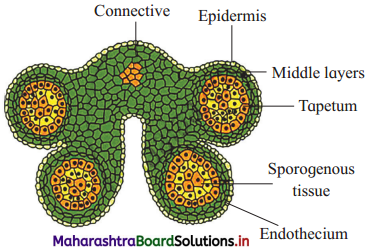
- Internally it shows four chambers called microsporangia or pollen sacs.
- The anther consists of two main parts, viz., anther wall and microsporangium or pollen sac.
- The wall of the anther can be differentiated into four layers, viz., epidermis, endothecium, middle layers and tapetum.
- The epidermis is the outermost layer of the anther wall. It is made up of flattened cells which are protective in function.
- The endothecium lies internal to the epidermis. It is made up of a single layer of cells. The cells of endothecium show fibrous thickenings on radial walls.
- Internal to the endothecium, lie 1 to 3 layers of parenchymatous cells forming middle layers of the anther wall. The cells of middle layers degenerate at maturity during the formation of microspores.
- The tapetum is the innermost nutritive layer of the wall of the anther, consisting of a single layer of cell surrounding the sporogenous tissue.
Question 5.
Describe the structure of a mature anatropous ovule or a typical angiospermic.
Answer:
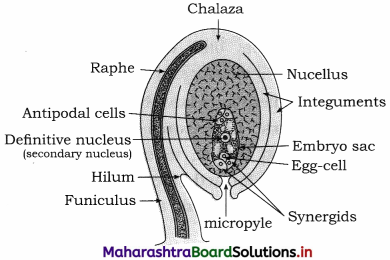
- The ovule which has a bent axis and downwardly directed micropyle is called anatropous ovule.
It is the most common type of ovule in angiosperms. - The matured anatropous ovule consists of two parts, viz., the stalk and the body. The stalk of the ovule is called the funicle or funiculus. The funicle attaches the ovule with the placenta.
- The point at which the funicle is attached to the body of the ovule is called hilum.
- Nucellus : It is made up of diploid parenchymatous cells.
The basal part of the nucellus is called chalaza.
The protective coverings of the nucellus are called integuments. - Micropyle : The integuments do not completely cover the nucellus. They leave a small opening called micropyle at the tip.
- Embryo sac : In a mature ovule, the nucellus shows an oval-shaped structure towards its micropylar end called embryo sac or female gametophyte.
Question 6.
Why do some plants have both chasmogamous and cleistogemous plants flowers?
Answer:
- When flowers open, their sex organs are exposed for further process of fertilization then it is chasmogamous condition.
- Pollinating agents can easily transfer pollen grains in such flowers for self as well as cross pollination.
- When flowers are closed, they are self pollinated in bud conditions then this condition is cleistogamy.
- When some plants have both of these types of flowers it ensures pollination and fertilization leading to seed setting. When seeds are formed then perpetuation of species is achieved as new plants will germinate from it.
Question 7.
What is pollination ? What are its two types ?
Answer:
1. Pollination : The transfer of pollen grains from the anther to the stigma is called pollination.
2. Types of pollination : Pollination is of two types, viz., self-pollination and cross pollination.
(i) Self-pollination (Autogamy) : The transfer of pollen grains from the anther to the stigma of the same flower or a different flower possessing the sam genetic make-up is called self-pollination.
(ii) Cross pollination (Allogamy) : The transfer of pollen grains from the anther of a flower to the stigma of another flower borne by a different plant possessing dissimilar genetic make-up is called cross pollination.
Question 8.
What are the different types of cross pollination based on the abiotic pollinating agents?
Answer:
Based on the abiotic pollinating agents, pollination can be either anemophily or hydrophily.
(1) Anemophily : Pollination with the help of wind is called anemophily. The wind pollinated plants are called anemophilous plants. Anemophily is seen in plants like grasses, maize, wheat, rice, palms, etc.
(2) Hydrophily : Pollination effected through the agency of water is called hydrophily. Water pollinated plants are called hydrophilous plants. Hydrophily is of two types viz., hypohydrophily and epihydrophily. Plants such a zostera, Vallisneria, etc. are hydrophilous plants.
Question 9.
What are different types of cross pollination based on the biotic pollinating agents?
Answer:
Cross pollination through biotic agents are entomophily, ornithophily and chiropterophily.
(1) Entomophily : Pollination effected through insects is called entomophily. Insect pollinated plants are called entomophilous. Entomophily is seen in plants like Hibiscus, Rose, Salvia, Oestrum, Jasmine, etc.
(2) Ornithophily : Pollination effected through the agency of birds is called ornithophily. Bird pollinated plants are called ornithophilous plants.
Ornithophily is seen in plants like Callistemon, Bombax, Butea, etc.
(3) Chiropterophily : Pollination effected through bats is called chiropterophily. Bat pollinated plants are called chiropterophilous plants. Chiropterophily is seen in plants like Anthocephalous (Kadamb tree), Adansonia (Baobab tree), Kigellia (Sausage tree).
Question 10.
Give the floral adaptations for chiropterophily.
Answer:
- The pollination that occurs with the help of bats is called chiropterophily.
- In chiropterous plants the flowers are large and stout enough in such a way that bats can hold onto the flowers.
- Chiropterous flowers are nocturnal, i.e., they open during the night time only.
- Flowers emit rotten fruits like fermenting fruity odours which attract bats.
- Flowers produce copious nectar.
- Flowers possess large number of stamens which produce large amount of edible pollen grains.
- Anthocephalus, Kigellia and Adansonia are chiropterous flowers.
Chart or Table based guestions
I. Complete the following charts
Question 1.

Answer:

Question 2.

Answer:

Question 3.
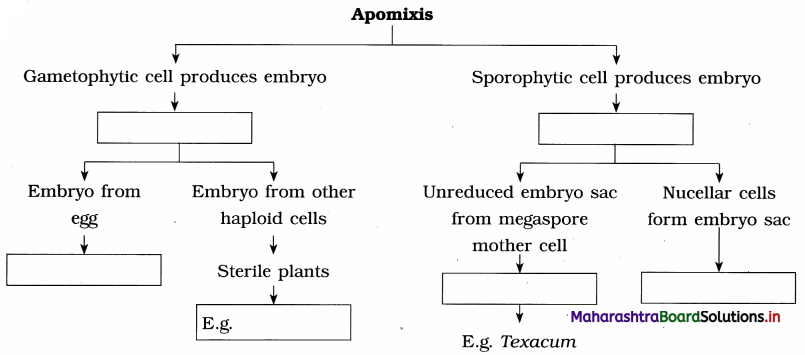
Answer:
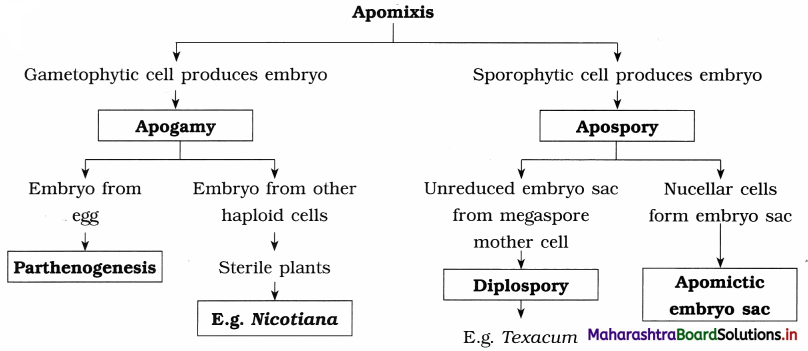
II. Complete the following tables
Question 1.

Answer:

Question 2.
Complete the table-Related to outbreeding devices.
| Type | Description | Example |
| 1. ———— | Unisexual flowers/Monoecious or dioecious plants | Papaya, Maize |
| 2. ———— | Mechanical device to prevent Self-Pollination – Natural physical barrier | —————- |
| 3. Prepotency | ——————– | Apple |
| 4. Heteromorphy | ——————– | Primula |
| 5. Protandry | Androecium matures earlier than gynoecium | —————- |
Answer:
| Type | Description | Example |
| 1. Unisexuality | Unisexual flowers/Monoecious or dioecious plants | Papaya, Maize |
| 2. Herkogamy | Mechanical device to prevent Self-Pollination – Natural physical barrier | Calotropis |
| 3. Prepotency | Pollens of other flower germinate rapidly rather than from same | Apple |
| 4. Heteromorphy | Presence of different forms of flowers with respect to Stigma and anthers | Primula |
| 5. Protandry | Androecium matures earlier than gynoecium | Sunflower disc florets |
![]()
Question 3.
| Hypohydrophily | Epihydrophily |
| 1. Porogamy | ————– |
| 2. ————– | Entry of pollen tube in Ovule piercing integuments |
| 3. ————— | Entry of pollen tube in Ovule through Chalaza |
Answer:
| Hypohydrophily | Epihydrophily |
| 1. Porogamy | Entry of pollen tube into Ovule through micropyle |
| 2. Mesogamy | Entry of pollen tube in Ovule piercing integuments |
| 3. Chalazogamy | Entry of pollen tube in Ovule through Chalaza |
Diagram based questions
Question 1.
T. S. of anther.
Answer:
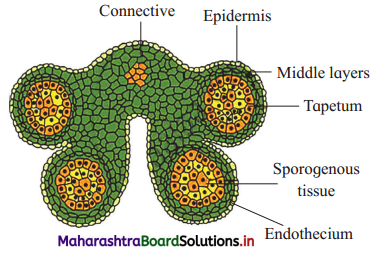
Question 2.
Development of male gametophyte
Answer:
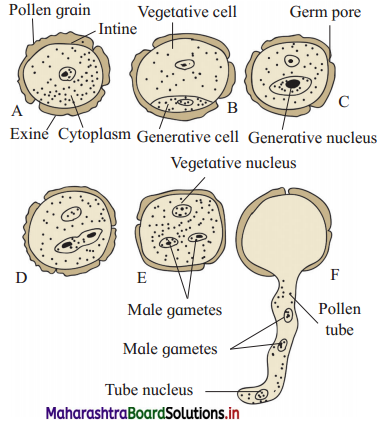
Question 3.
Development of female gametophyte
Answer:
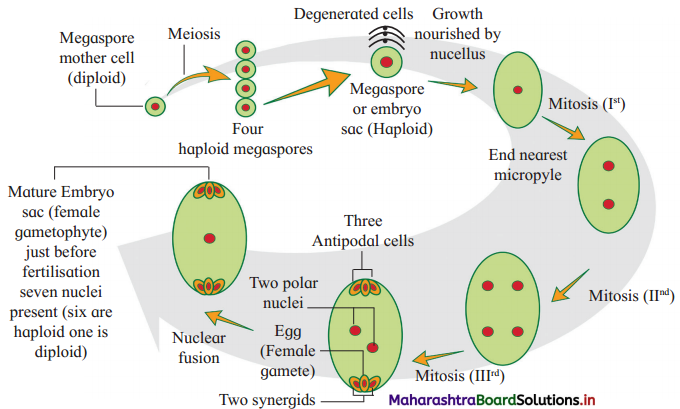
Question 4.
Double fertilization
Answer:
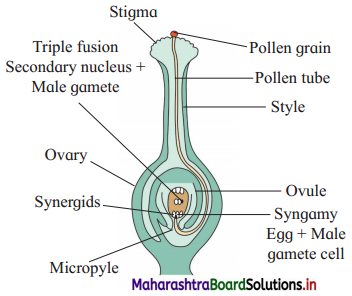
Question 5.
Maize Seed.
Answer:

Question 6.
Entry of pollen tube into Ovule – Porogamy
Answer:
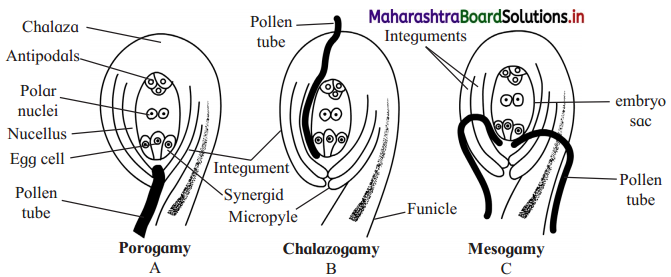
Long Answer Questions
Question 1.
Describe the types of reproduction in lower plants (i) Budding and (ii) Sporulation. Illustrate your answer with suitable diagrams.
Answer:
(i) Budding:
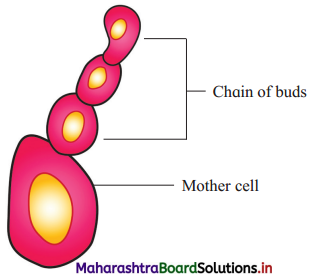
- It is a type of asexual reproduction.
- It is of very common occurrence in unicellular organism yeast.
- It is observed in favourable condition.
- Mother cell produces small outgrowth which is known as bud.
- Buds maybe one or more and on separation, they grow as new individual.
(ii) Spore formation/Sporulation:
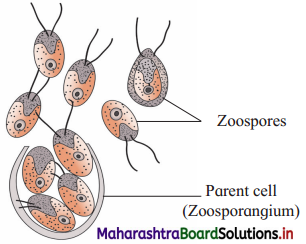
- It is a tpe of asexual reproduction.
- It is of very common occurrence in lower plants.
- It occurs by production of motile zoospores that are formed in sporangia.
- Flagellated zoospores when liberated can grow independently into new individuals.
- Biflagellate zoospores are formed in algae Chlamydomonas.
Question 2.
Describe the structure of a mature pollen grain.
OR
Sketch and label pollen grain.
Answer:
- A typical angiospermic pollen grain (mature) is a unicellular, uninucleate, spherical or oval haploid structure.
- The pollen grain is also called microspore.
- It is covered and protected by a double layered wall called sporoderm.
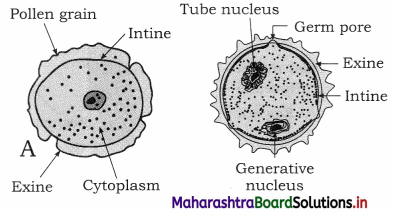
- The outer layer of the wall is thick. It is known as exine. The inner layer of the wall is thin. It is known as intine.
- The exine is made up of a complex substance called sporopollenin. The sporopollenin protects the pollen grain from physical and biological decomposition.
- The exine is spiny in insect pollinated plants, with sculptured pattern or smooth in wind pollinated plants.
- The exine is not continuous throughout. It is interrupted, very thin at one or more places by small pores called germ pores.
- The intine which is composed of cellulose and pectin encloses the protoplasm with a single haploid nucleus.
Question 3.
Describe the development of female gametophyte in angiosperms.
OR
What is megasporogenesis ? Give an account of development of the female gametophyte.
OR
With a neat diagram explain the 7-celled, 8-nucleate nature of the female gametophyte.
Answer:
1. Megasporogenesis : The process by which . the diploid megaspore mother cell of nucellus undergoes meiosis to form a tetrad of haploid megaspores is known as megasporogenesis.
2. Development of female gametophyte:
(i) The diploid megaspore mother cell undergoes meiosis to form a linear tetrad consisting of four-haploid megaspores. Generally, the chalazal megaspore becomes the functional megaspore. The other three megaspores degenerate.
(ii) The chalazal megaspore (fertile megaspore) is the first cell of the female gametophyte. It undergoes enlargement and develops into the female gametophyte. The haploid nucellus of chalazal megaspore undergoes three successive free nuclear mitotic divisions to produce eight nuclei. Of these, the first mitotic division results in the formation of two nuclei.
(iii) Both these nuclei undergo two successive mitotic divisions resulting in the formation of four nuclei at both the poles. In the meantime, one nucleus from each pole called polar nucleus moves towards the centre of the embryo sac and fuse to form a diploid nucleus called secondary nucleus.
(iv) The three nuclei at the micropylar end are organised to form a three-celled structure called egg apparatus, while the other three nuclei at the chalazal end reorganise to form three antipodal cells. The egg apparatus consists of a central cell called egg cell or female gamete which is flanked by two lateral cells called synergids.
(v) The female gametophyte consists of an egg apparatus, a secondary nucleus and three antipodal cells, A7 celled 8 nucleated structure.
![]()
Question 4.
What are the three types of endosperm? Describe them briefly.
Answer:
There are three types of endosperm, viz., nuclear, cellular and helobial.
(i) Nuclear endosperm:
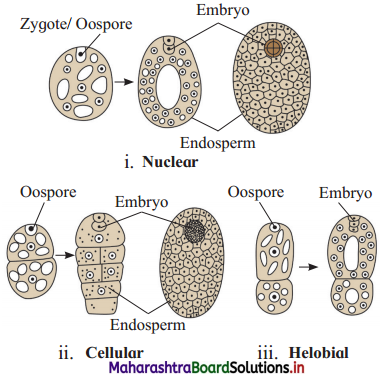
- Nuclear endosperm is the most common type of endosperm.
- During the formation of nuclear endosperm, the primary endosperm nucleus (PEN) undergoes free nuclear division forming a large number of triploid nuclei which remain freely suspended in the common cytoplasm of central cell.
- A central vacuole pushes the nuclei towards periphery.
- Later on wall formation takes place around these nuclei to form a cellular mass.
- It is seen in plants like maize, sunflower, wheat, coconut, etc.
(ii) Cellular endosperm:
- In this type of endosperm, the triploid primary endosperm nucleus undergoes nuclear divisions followed by cytokinesis.
- Owing to this, the development of endosperm occurs in cellular form.
- It is less common and seen in dicot plants like Datura, Petunia, Balsam, Adoxa.
(iii) Helobial endosperm:
- In helobial type of endosperm, the first division of the primary endosperm nucleus is followed by the formation of cell wall.
- Owing to this, the central cell is divided into a large micropylar cell and a small chalazal cell.
- In both micropylar and chalazal chamber, the further development of the endosperm is of nuclear type.
- Walls develop between nuclei in micropylar chamber.
- This type of embryo development is seen in plants belonging to order Helobiales of Monocots. e.g. Asphodehis.
Question 5.
What is apomixis? Explain the categories of apomixis.
Answer:
(i) Apomixis : The phenomenon of formation of embryo(s) by asexual methods without formation of gametes and fertilization is termed as apomixis.
(ii) There are three main categories of apomixis.
- Recurrent
- Non-recurrent and
- Adventive embryony.
1. Recurrent apomixis : In this diploid sporophytic cell, archesporial cell or nucellus form embryos, When diploid megaspore mother cell forms embryo sac it is known as diplospory. It is also called apospory.
2. Non-recurrent apomixis : Haploid embryo sac is formed but the embryos arise either from egg cell or any other haploid cell. It is also known as apogamy.
3. Adventive Embryony : In this in addition to normal zygotic embryo, additional embryos develop from nucellus or integuments. It results in polyembryony.